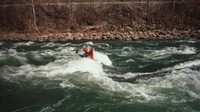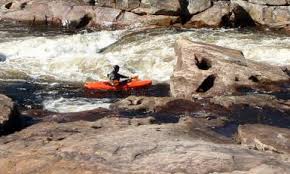Waves
 Waves (AKA: Haystacks, Wave Trains) - A wave is caused by a constriction in the river and a drop over a ledge. Waves are for the most part quite safe. Reactionary waves are caused by the river ricocheting off the side of the river. A great technique in large waves is to maintain a steady paddling cadence and boat scout at the top of the wave. For the most part, the easiest ride is perpendicular to the wave front. Here is an example of a wave from the New River Gorge.
Waves (AKA: Haystacks, Wave Trains) - A wave is caused by a constriction in the river and a drop over a ledge. Waves are for the most part quite safe. Reactionary waves are caused by the river ricocheting off the side of the river. A great technique in large waves is to maintain a steady paddling cadence and boat scout at the top of the wave. For the most part, the easiest ride is perpendicular to the wave front. Here is an example of a wave from the New River Gorge.
Waves are generally a great deal of fun. When running wave trains, maintain your speed downriver and scout at the wave tops. It is really easy to make turns at wave tops since the ends of your boat are out of the water. Look for major obstructions like rooster tails and holes so you can easily avoid them. Here is a video of a canoe running Hermit Rapids on the Grand Canyon, a really famous wave train rapid: Hermit Rapid in a Canoe.
Eddies and eddy lines
 Eddies are your friend! All good boaters catch eddies and use them to control their descent downstream. A good rule of thumb in paddling is to never leave an eddy until the coast is clear from above and you can see how to reach an eddy below. Here is an excellent diagram of an eddy:
Eddies are your friend! All good boaters catch eddies and use them to control their descent downstream. A good rule of thumb in paddling is to never leave an eddy until the coast is clear from above and you can see how to reach an eddy below. Here is an excellent diagram of an eddy:
Eddy lines (or fences) can sometimes be tricky to navigate. The main body of water rushes downstream and the current in an eddy runs back upstream. Between these to opposing currents is the eddy line. When catching eddies, we puncture the wall perpendicularly and drive/pull across them. If your angle of attack is closer to parallel, you will bounce along the eddy line. Here is a nice video that explains and shows eddy lines: Eddy Lines
Water reading (upstream and downstream Vs)
Identifying downstream and upstream V's of water is probably the simplest form of river reading. Downstream V's are that really nice tongue of water that is so much fun to ride over. Look beside this tongue and you will notice an eddy, a great place to catch a breath and look further downstream. Upstream V's occur when a rock/boulder splits a channel. We generally avoid these features or ride close to catch the eddy behind that rock.
The Downstream V
 Downstream V Rapids are formed by water running over and around rocks and ledges. The most basic feature is the downstream V that develops when water runs between two rocks. This feature is also known as a tongue. Generally, this is what you want to aim for.
Downstream V Rapids are formed by water running over and around rocks and ledges. The most basic feature is the downstream V that develops when water runs between two rocks. This feature is also known as a tongue. Generally, this is what you want to aim for.
The Upstream V
The opposite of this feature is an upstream V. In an upstream V, water rushes around a rock. In the previous picture, you can clearly see two upstream V's. In general, we try to avoid upstream V's or at least lean into the rock to avoid capsizing.
Subjective vs. objective hazards
The Risks
Many boaters start when they are young and fearless. In the old days, we paddled in fiberglass boats that put a premium on running rivers clean (not hitting rocks). We had an extra incentive to be cautious. Today's boats are somewhat indestructible. Hitting rocks doesn't crack the hull anymore. We even use rocks for certain moves. The learning curve has also been significantly reduced. Many boaters are paddling class III whitewater in their first year of boating, some are even paddling class V runs. The above changes in our sport leave little time to develop sound river judgment and experience to recognize dangerous situations. Training, practice, and patience when "Stepping Up" are the best way to avoid becoming a statistic. Fortunately we have learned a great deal over the years and have access to much better information sources and excellent formal training. You may find this article on judgment interesting as well as the contained links for further study: Judgment.
Floods
Floods are a special concern for river running. Besides the extreme power of water associated with flooding, there are many other hazards that might not be as obvious. Floods often topple trees along their river banks. These trees form death traps called strainers or sweepers. In large floods, large trees and boulders float downstream with the rest of the river. Trash like old refrigerators, cars, and barrels often get swept into the river - all of which can form nasty entrapment obstacles. Storm runoff in metropolitan areas include sediment, oil, fertilizer, and herbicides. Overtaxed sewage treatment facilities often overflow in floods as well. Why bother paddling streams in severe flood stage when you can finally catch smaller streams that seldom run.
Page 3 of 4
